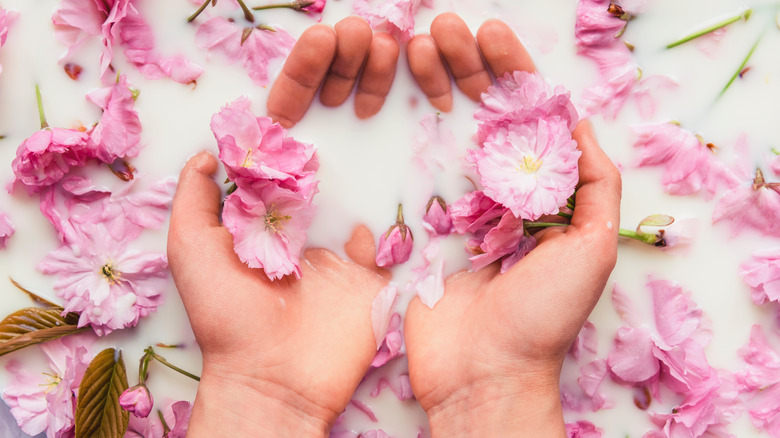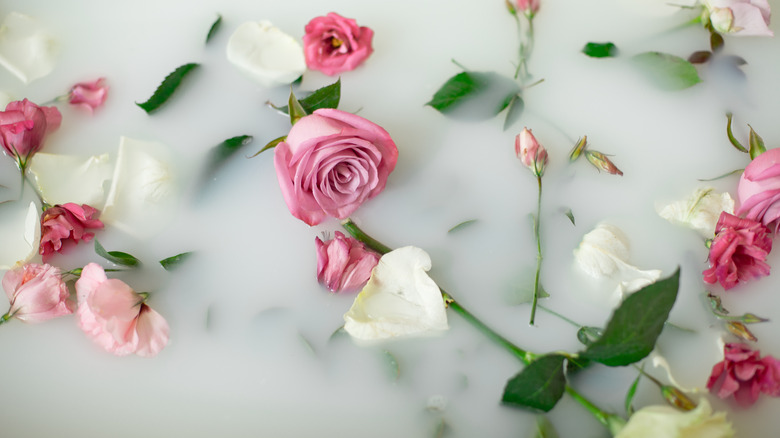Can Milk Baths Be Used To Treat Dry Skin?
Winter is coming, and that means the temperatures are dipping. With the colder weather, dry skin becomes more of a problem. If you suffer from extra dry skin and have tried all of the latest lotions to come into the market, there's an ancient treatment that just could do the trick: milk baths. Legend has it that Cleopatra's secret to a glowy complexion was milk and honey baths, per Very Well Health. The ancient Romans took regular milk baths, and during the late 1800s to the early 1900s, people turned to washing their face with buttermilk.
According to Healthline, milk baths consist of warm water and either liquid or powdered milk. Milk contains proteins, fats, vitamins, minerals, and lactic acid, which make it a potentially beneficial skincare ingredient. Very Well Health notes that there is a lack of solid scientific studies that prove whether milk baths have any definitive effects on the skin, but anecdotal evidence does point to skincare benefits. The fats in the milk coat your skin while the proteins strengthen the skin barrier, which help your skin feel smooth and soft. The end result is a silky, but not greasy, hydrated feeling.
The benefits of a milk bath
Milk baths can benefit those dealing with dry skin, and may help those dealing with eczema and/or psoriasis, per Healthline. However, it's important to note that milk baths cannot be used as a substitute for any prescription medication for eczema or psoriasis. There's limited information from scientific studies as to whether milk baths are effective against eczema.
According to a study published in the peer-reviewed journal called "Nutrients," the topical application of human breast milk on babies with eczema is as effective of a treatment as hydrocortisone ointment. While further research is necessary, researchers point out the possible benefits from the breast milk stem cells. Another study published in "Women's Dermatology" found that milk baths can relieve the symptoms of pruritus, or itchy skin in women over 65.
Dr. Michelle Henry, clinical instructor of dermatology at Weill Cornell Medical College, told Yahoo! Life, "Milk baths can have tons of great benefits for your skin. They can soothe and hydrate skin, whether it's dry, itchy or just generally irritated." Dr. Henry added, "The lactic acid in milk acts as a mild alpha hydroxy acid, which helps with exfoliation." The mild exfoliation treats rough, dry patches and creates a supple skin texture. According to Byrdie, milk can also help soothe poison ivy and sunburns, as well as soothe inflamed skin.
Who will — and won't — benefit from a milk bath
To boost the hydrating effects of a milk bath, you can add sea salt which will moisturize your skin and strengthen the skin barrier, Aveeno suggests. Adding honey to your milk bath will help soften and moisturize extra dry skin. Dr. Loretta Ciraldo, a Miami-based dermatologist told Byrdie, "When you add in certain types of milk – buttermilk especially or oat milk for the calming benefits of oat – you get greater calming and anti-itch benefits."
According to Very Well Health, lactose-intolerant people should be able to take milk baths, as bathing in milk should not cause any digestive problems. However you should not take a milk bath if you have a milk allergy, as it can cause itching, rash, and or/hives. Those with sensitive skin should also avoid milk baths, as your skin could actually get irritated by the lactic acid in milk, Healthline notes. Make sure to consult with your dermatologist before trying milk baths.
While it may not feel as extravagant as living in a land of milk and honey, bathing in milk and honey can give you a luxurious spa-like experience that will nourish dry skin.


